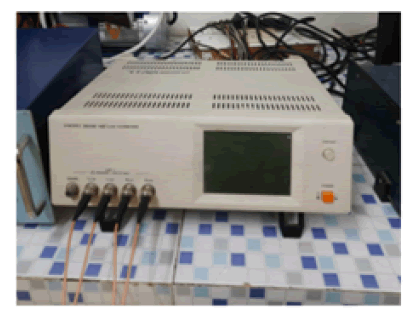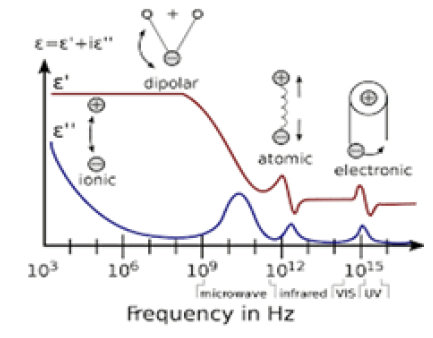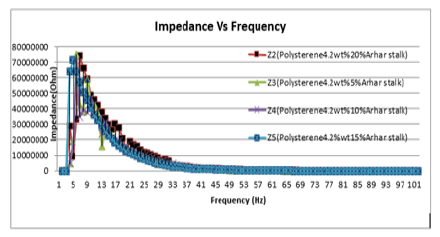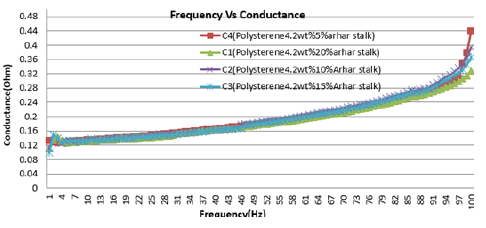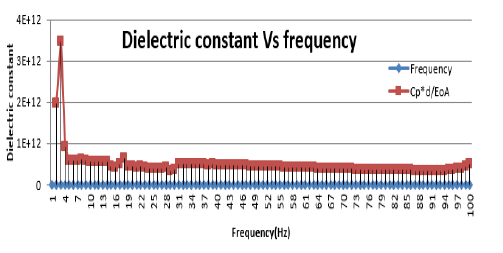Research Article - Clinical Investigation (2023) Volume 13, Issue 3
Study of dielectric behavior of high density polystyrene with agro waste composites
- Corresponding Author:
- Vinod Kumar Kushwah
Department of Physics, Hindustan College of Science & Technology, Farah, Mathura-2811229U.P.) India
E-mail: kushwahvk2000@gmail.com
Abstract
Polymer composites have been prepared with natural fibres obtained from the agro waste of pigeon pea stalk as reinforcing material using waste polystyrene as matrix by solvent casting method. The samples were tested for their dielectric properties (dielectric constant (ɛ ), Loss factor (ɛ ), conductivity (σ) and impedance (χ) of Polystyrene and cellulose fibers composites. Results prove that the addition of fibers of Pigeon pea stalk increases the dielectric constant, loss factor and impedance of the materials compared to the effect of low frequency. Composites with 5%, 10wt%, 15wt%, and 20wt%fiber contents showed the highest value at lower frequency level conductivity. All weight percent composites' volume resistivity was examined, and it was discovered that it decreased with frequency and fibre content. The reinforced polymer displayed a thermal behaviour that was halfway between fibres and polymers.Keywords
Cellulose fibers • Polystyrene • Dielectric properties • Agro waste composites
Introduction
The production and use of wood and natural fiber reinforced thermoplastics has increased significantly [1–3]. The possible uses of these resources are essentially limitless. Natural fiber polymer composites are utilized in the automobile industry, decking, garden furniture, and window and door profiles[4, 5]. Due to their low manufacturing costs, simplicity of processing, biodegradability, and availability, wood or natural fibers are frequently employed as a reinforcing element in polymer fiber composites [6–8].
Thermoplastic matrices can incorporate natural fibers in sufficient quantities for cost-effective solutions and environmental advantages [9, 10]. However, due to a lack of understanding regarding their behavior in electric fields of various intensities, frequencies, and temperatures natural fiber-polymer composites aren't frequently used in electrical engineering. There are few studies on the variation of the electrical and dielectric characteristics of natural polymer fiber composites [11-13]. Natural fiber polymer composites' dielectric characteristics are regulated by a number of variables, including frequency and matrix. It is a natural fiber made from diverse agricultural wastes that includes reinforcements scattered throughout the bulk of the fiber in a polymer matrix. Determine their suitability for electromagnetic applications such as insulators, fillers, and substrates for antenna design would benefit from a detailed investigation of the many aspects impacting the dielectric characteristics of natural fibers and polymer composites [14, 15].
Because of their strength, superior moisture performance, stiffness, low density, low cost, and, above all, their ability to utilize waste, natural fibers made from agricultural waste have found applications in the polymer sector [9, 10]. Plant fibers have drawn a lot of interest in the last 20 years as an alternative to synthetic fiber reinforcements. Composites' favorable corrosive qualities, together with their increased specific strength and lower life cycle costs, have aided in their development. Many countries face the problem of severe environmental pollution due to burning of crops residue after harvest. The burning of agro waste deteriorates the quality of air. Many environmental issues can be resolved by the use of agro based natural fibers are polymer composite. Recent polymer composites have employed natural fillers made from diverse crop leftovers as reinforcement. [10-16] Natural fiber based composite materials find extensive use for their dielectric applications. The moisture present in agro waste fibers, increase the conductivity of composites. The correlation of heat treatment resistivity and dielectric constant of natural fiber reinforced polymers has been studied.
The inclusion of natural cellulosic materials as fillers in polymer matrices in substitute of synthetic materials is receiving more interest in the aerospace and automotive industries as a result of the expanding usage of polymer composites and global environmental concerns.
In contrast to more common synthetic fibers like glass and carbon, plant fibers can offer composites advantages including low density, high rigidity, low cost, renewable and biodegradable, environmentally benign, and a high degree of processing flexibility. The plant fiber is cellulose, a glucose polymer bonded to lignin with different proportions of other natural components. It is frequently generated from vegetables. However, some types of synthetic fibers, such modal rayon and lyocell, are derived from natural cellulose. Synthetic fibers are often made from synthetic ingredients like petrochemicals. [3].
Expanded polystyrene, also called polystyrene, is a high-performance, low-cost thermoplastic predominantly utilized in building materials and consumer goods packaging. Large volumes of polystyrene trash are produced in both households and industry, despite the material not degrading [14-16]. Since polystyrene's production, usage, and disposal have negative effects on the environment, its alternate use as a matrix in the creation of composite materials has emerged [17].
Preparation of a composite
Manual mixing and hand lay-up techniques were used to create the composite. Pigeon pea stem fibers were combined with solvated polystyrene resin in concentrations of 5, 10, and 20 weight percent, respectively. The composite samples were mounded, and they were left to cure for seven days at room temperature.
In these studies, a natural fiber reinforced polymer composite is developed, its dielectric properties in the microwave range are determined, and the effects of thermal stability, dielectric properties, dielectric constant, dissipation factors, volume, resistivity, and conductivity of pigeon pea high-frequency nature examine fiber composite materials from 1 MHz to 1 GHz are also examined.
Materials and Methods
Materials
Solid packaging waste was used to create waste polystyrene. The solid polystyrene was dissolved in a specified solvent to create a solvated resin. Abdul Kareem and Adenitis explanation of the dissolution process [13].
After the crop was harvested, leftover pigeon pea stalks were gathered from a nearby field. By mechanically cutting and hammering the stalk, the fibers were separated, and the fibers were then removed from the stalk. Three days were given for the fibers to air dry. (Table 1) In this work, polystyrene using pigeon pea stalk fibers are synthesized by using solution casting method. Three different filler loading (5%, 10%, 15%, 20%) are three different sizes (250-355µ, 355-500µ, 500-700µ) composites were utilized for studying, and the effect of compositions on different mechanical properties of the synthesized composites (Table 2 and Table 3).
Table 1. The size of pigeon pea
| S.No. | Polystyrene(mg) | Pigeon Pea Stalk wt% | Total sample size with weight(mg) | Size(µm) |
|---|---|---|---|---|
| 1 | 4.2 | 5%=.225mg | 4.425 | 200-250 |
| 2 | 4.2 | 10%=.450mg | 4.65 | 250-355 |
| 3 | 4.2 | 15%=.675mg | 4.875 | 355-500 |
| 4 | 4.2 | 20%=.900mg | 5.1 | 500-700 |
Table 2.Properties of polystyrene and Pigeon wood
| Property of material | Polystyrene | Pigeon wood |
|---|---|---|
| Formula | (C8H8)n | Complex |
| Density | 1.04 g/cm3 | 1.50g/cm3 |
| Melting point | 2400C for isotactic PS | - |
| Grass transition point | 1000C | - |
| Thermal conductivity | .033 W/(m-K) | .1713 W/(m-K) |
Table 3. Compared Sudanese C. cajan to India C. cajan
| Chemical composition% | Sudanese C. cajan | Indian C. cajan |
|---|---|---|
| Ash content | 3.7 | 1.72 |
| Silica content | 0.22 | 0.56 |
| Cold water solubility | 12.5 | 3.42 |
| Hot water solubility | 14.26 | 5.1 |
| Alcohol cyclo-hexane | 2.15 | 4.14 |
| 1% sodium hydroxide | 30.93 | 19.6 |
| Holocellulose | 77.5 | |
| Pentosan | 18 | 15.97 |
| Cellulose | 46.48 | 47.31 |
| Acid insoluble lignin | 22.09 | 18.72 |
| Cellulose/ lignin ratio | 02:01 | 2.5:1 |
On the basis of this inherent parameter film of material polystyrene with Indian C.cajan (Pigeon pea stalk) and Pigeon pea stalk were synthesized and the sample were found to have very good relation of dielectric properties of insulating materials on lower frequency range.
Testing of composite samplesa
As expected, the volume resistance of biocomposites decreases with increasing frequency. The decrease in volume resistivity is due to the pole groups that allow the current to flow. The other hand resistivity decrease but the conductivity increases (0.12 Ω -0.44 Ω) due to increases in frequency. Figure 1 shows the change in volume resistivity with frequency for composite samples.
LCR high tester metres were used to measure the composite samples' dielectric characteristics. (Model No. HIOKI 3538-50). The dielectric constant, impedance, loss factor measurements were determined using by LCR High tester meter. Up to 5 MHz can be measured using the LCR metre. The 50 mm in diameter and 5 mm in thickness disk-shaped samples. The contact electrode method, which employs a hard metal electrode, was used to examine samples. Prior to testing, all samples were dried for 24 hours at 70°C in a vacuum chamber. At each frequency, all samples were examined ten times, and the HP impedance analyzer then recorded the average result (Figure 1).
Mechanism and data characterization
Theoretical Background
Composite materials find extensive use for their dielectric applications. Composites' conductivity is increased by the moisture that is contained in agricultural waste fibers. It has been investigated how natural fiber reinforced polymers' dielectric constant and heat treatment resistance relate to one another.
As it can lower the energy losses in the transmission lines, this parameter aids in the selection of the dielectric capacitor material to be used in the design and construction of the right capacitor value to be utilised in the capacitor bank. A dissipation factor of can be used to describe electrical losses, or the amount of energy lost by the insulating material when a voltage is supplied to the circuit. The ratio of the total electrical power flowing through the circuit to the electrical power dissipated in the material is known as the dissipation factor (tan). Because the dissipation factor is a gauge of how much electrical energy is being transformed into heat in an insulating material, measuring the tan of an insulating material is crucial
In this paper, Before the explanation of the variation of the dielectric constant with frequency, the frequency dependence of the dielectric constant was established.
The total polarization P=Ps + Po + Pi + Pe (1)
Where Ps = space charge polarization, Po = Orientation polarization, Pi = Ionic polarizarion, Pe = Electronic Polarization.
In Figure 2, when an external electric field is applied across parallel plates functioning as a capacitor, the material's dielectric constant is used to quantify the material's capacity to polarize and store charge. The polarizability of a material affects the dielectric constant of that material. The dielectric constant will be high if the molecule has a high degree of polarizability. The dipolar, atomic, polarized, electronic, and spatial charges affect a polymer's dielectric constant. Instantaneous polarization components such as electronic and atomic polarization are only detectable at high frequencies. Dipole or orientation polarization happens because the substance contains polar groups. This is denoted by the symbol r and is also referred to as relative permittivity. An object's dielectric constant [18]. Cellulosic fibers, in general, incorporate a polar group into the polymer, causing dipolar polarization and raising the dissipation factor and dielectric constant. However, the polymer now contains 5% to 20% more cellulose by weight than before. It has no impact on the materials' volume resistance. The dielectric characteristics are also impacted by temperature changes Heating natural fiber-based composites makes the dipoles more mobile, which improves the orientation polarization and dielectric characteristics.
Dielectric materials can have poor conductivity even when they have high resistance, especially at high frequencies.
Prior research revealed that the conductivity of polystyrene pea stalk and freckle composites increased gradually with frequency and fiber concentration (Figure 3). The dielectric constant is significantly influenced by this conductivity. (Figure 4).
Numerous studies show that the improvement of a thermoplastic polymer is mechanical and that the physical properties are due to the addition of cellulosic fibers [19].
This study analyzed how the fibers in pigeon pea stalks affected the dielectric characteristics and revealed a strong correlation between the cellulose content and dielectric constant.
At various weights, it was discovered that the polystyrene film's impedance (7.6×107 ohms) mixed. In the low frequency range from 1 Hz to 1 MHz, the pigeon pea stem material (5%, 10%, 15%, 20%) had a satisfactory response, reflecting the few studies investigating the impact of cellulosic fibers on the dielectric characteristics of polymer-wood composites. It is crucial to research a dielectric material's volume resistivity because it is the most significant insulator characteristic. The moisture content, crystalline and amorphous components, chemical composition, and presence of contaminants all affect how resistant reinforced composites are
In this study, the effect of pigeon pea stem fibers on the dielectric characteristics was examined in light of their benefits for mechanical and thermal process stability (Figure 5). The amount of cellulose in the composite and the dielectric constant were found to be closely related. Compared to wood or natural fiber composites, cellulosic fiber-based bio composites would have a superior dielectric. However, only a small number of research have looked at how cellulose fibers affect WPC's dielectric characteristics in the low-frequency band between 1Hz and 1MHz. To our knowledge, no work has looked into the dielectric response of cellulosic composites over a broad frequency range at high cellulose contents of up to 20% by weight. Composites weighing between 1 and 15 wt.
The findings demonstrated that the maximum values for tension, deflection, and hardness for the three types of stress were produced by pressure magnitudes of 250-355 and 5%.
The dispersion of the fibers has an impact on conductivity as well. In reality, when there is little fiber present, the distribution of the fibers is too haphazard to allow the current to flow. The large fiber concentration, however, results in a uniform dispersion and promotes the conduction phenomena.
Using IBM SPSS version 27, the dielectric characteristics (dielectric loss) were subjected to an ANOVA and a user-defined factor model. The fiber type (polystyrene, pigeon wood stick wt.) and frequency (1 Hz to 1 MHz) were the test factors. All variables were evaluated. At p 0.05, the effect and the variances between the means were deemed statistically significant. The residual vs the expected observed value and Levine’s test for equal variances were used to assess the ANOVA hypotheses (Table 4 and Table 5).
Table 4. Significant Variance
| SUMMARY | ||||
|---|---|---|---|---|
| Groups | Count | Sum | Average | Variance |
| Column 1 | 100 | 7.99E+08 | 7988392 | 2.36E+14 |
| Column 2 | 100 | 1.00E+104 | 1.00E+102 | 1.00E+206 |
Table 5. ANOVA hypotheses
| ANOVA | ||||||
|---|---|---|---|---|---|---|
| Source of Variation | SS | df | MS | F | P-value | F crit |
| Between Groups | 5.00E+205 | 1 | 5.00E+205 | 1 | 0.31853 | 3.88885 |
| Within Groups | 9.90E+207 | 198 | 5.00E+205 | |||
| Total | 9.90E+207 | 199 | ||||
The findings also demonstrated that the relationship between fiber type and frequency has a major impact on the dielectric constant and resistivity. Additionally, a statistically insignificant but significant one-way interaction had an impact on’ and ', suggesting that the frequency of the effect of fiber content fluctuates.
In Additionally, the dielectric constant affects the resistivity. This image demonstrates how the composite's volume resistivity falls off exponentially as the decay constant rises.
Conclusions
The creation of cellulosic composites is particularly interesting because cellulose fibers offer the thermoplastic polymer many advantages. The volume resistivity, conductivity, dissipation factor, and dielectricconstant all vary with frequency. The composite's dielectric constant declines with frequency,but it does so at considerably higher frequencies. The dielectric characteristics of the composites have increased to lower levels due to higher fiber content. Higher cellulose content levels also result in an increased dielectric constant. The dissipation factor, on the other hand, comparing them to fiber composites, agricultural waste composites have higher dielectric characteristics. The frequency and charge of the fibers caused the bio composites' conductivity to rise, while their resistance fell. Comparing bio composites to the more popular electrical insulating techniques, they have demonstrated competitive qualities. The discrepancy between the crystallinity and the quantity of hydroxyl groups mostly explains the discrepancies in the dielectric characteristics between agricultural-based composites and fiber composites.
References
- Zafar MF, Siddiqui MA. Effect of filler loading and size on the mechanical and morphological behaviour of natural fibre-reinforced polystyrene composites. Adv Mater Process Technol. (2021);7(4):647-59.
- Onifade D, Ighalo J, Adeniyi A, et al. Morphological and Thermal Properties of Polystyrene Composite Reinforced with Biochar from Plantain Stalk Fibre. Mat Int. (2020);2:0150-0156.
- Adeniyi AG, Onifade DV, Abdulkareem SA, et al. Valorization of plantain stalk and polystyrene wastes for composite development. J Polym Environ. (2020);28(10):2644-51.
- Ighalo J, Adeniyi AG, Owolabi O, et al. Moisture absorption, thermal and microstructural properties of polymer composites developed from rice husk and polystyrene wastes. Int J Sustain Eng. (2021);14(5):1049-58.
- Anbupalani MS, Venkatachalam CD, Rathanasamy R. Influence of coupling agent on altering the reinforcing efficiency of natural fibre-incorporated polymers–A review. J Reinf Plast Compos. (2020); 39(13-14):520-44.
- Lide D. CRC Handbook of chemistry and Physics. (2004).
- Ju S, Chen M, Zhang H, et al. Dielectric properties of nanosilica/lowdensity polyethylene composites the surface chemistry of nanoparticles and deeptraps induced by nanoparticles. Express Polym Lett. (2014);8(9):682-91.
- Zafar MF, Siddiqui MA. Preparation and characterization of natural fiber filled polystyrene composite using in situ polymerisation technique. Adv Mater Process Technol. 2020;8(1):1-11.
- Verma D, Goh K. Effect of Mercerization/Alkali Surface Treatment of Natural Fibres and Their Utilization in Polymer Composites: Mechanical and Morphological Studies. J Compos Sci. (2021);5(7):175.
- Moustafa H, El-Wakil A, Nour MT, et al. Kenaf fibre treatment and its impact on the static, dynamic, hydrophobicity and barrier properties of sustainable polystyrene biocomposites. RSC Advances. (2020);10(49):29296-305.
- Notingher PV, Stanchu C, Enescu I, et al. Dielectric properties of wood-polymer composites. Matter Plast. (2010);47:393-98.
- Elloumi I, Koubaa A, Kharrat W, et al. Dielectric properties of wood-polymer composites: Effects of frequency, fiber nature, proportion, and chemical composition. J Compos Sci. ( 2021);5(6):141.
- Shabnam T. Mechanical and electrical properties of surface treated rice straw reinforced polypropylene composites. (2011).
- Wang X, Chang L, Shi X, et al. Effect of Hot-alkali Treatment on theStructure Composition of Jute Fabrics and Mechanical Properties of Laminated Composites. Materials. (2019);12(9):1386.
- Zhong Y, Tran LQ, Kureemun U, et al. Prediction of the Mechanical Behaviour of Flax Polypropylene Composites Based on Multi - Scale Finite Element Analysis. J Mater Sci. (2017);52(9):4957-67.
- Mangalaraja R, Raj TM, Prabha DR. Statistical Features of Epoxy Resin Based Hybrid Composites Reinforced With Jute, Banana And Flax Natural Fibers. J Chem Technol amp; Metall. (2019);54:1.
- Kulkarni M, Radhakrishnan S, Samarth N, et al. Structure, Mechanical and Thermal Properties of Polypropylene Based Hybrid Composites with Banana Fiber and Fly Ash. Mater Res Express. (2019);6 (7):075318.
- George G, Joseph K, Nagarajan ER, et al. Dielectric behavoiur of PP/jute yarn commingled composites: effect of fibre content, chemical treatmens,temperature and moisture. Compos Part A Appl Sci Manuf. (2013);47:12-21.
- Migneault S, Koubaa A, Erchiqui F, et al. A. Effect of processing method and fibre size on the structure and properties of wood plastic composites. Compos Part A Appl Sci Manuf. (2009);40(1):80-5.
